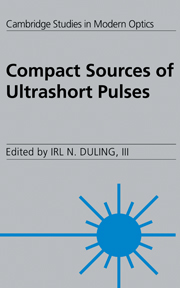Book contents
- Frontmatter
- Contents
- List of contributors
- Acronyms and abbreviations
- Preface
- 1 Short pulse generation
- 2 Passive modelocking in solid state lasers
- 3 Compact modelocked solid state lasers pumped by laser diodes
- 4 Modelocking of all-fiber lasers
- 5 Nonlinear polarization evolution in passively modelocked fiber lasers
- 6 Ultrafast vertical cavity semiconductor lasers
- 7 High power ultrafast semiconductor injection diode lasers
- 8 The hybrid soliton pulse source
- 9 Monolithic colliding pulse modelocked diode lasers
- Index
3 - Compact modelocked solid state lasers pumped by laser diodes
Published online by Cambridge University Press: 20 January 2010
- Frontmatter
- Contents
- List of contributors
- Acronyms and abbreviations
- Preface
- 1 Short pulse generation
- 2 Passive modelocking in solid state lasers
- 3 Compact modelocked solid state lasers pumped by laser diodes
- 4 Modelocking of all-fiber lasers
- 5 Nonlinear polarization evolution in passively modelocked fiber lasers
- 6 Ultrafast vertical cavity semiconductor lasers
- 7 High power ultrafast semiconductor injection diode lasers
- 8 The hybrid soliton pulse source
- 9 Monolithic colliding pulse modelocked diode lasers
- Index
Summary
Introduction
The development of commercially available laser diodes (LDs) has revolutionised solid state lasers so much so that today the term solid state lasers normally implies laser diode pumping. The change started in the mid 1980s with the commercial release of GaAs LD arrays capable of generating between 50 mW and 250 mW around 800 nm and capable of optically pumping Nd doped laser hosts. Subsequently, the range of available wavelengths and the power levels from LDs has increased dramatically, particularly around 980 nm, 800 nm and 670 nm, so that almost every possible dopant and host combination is capable of being LD pumped. In parallel with the improving technology for the pump sources, a new understanding of techniques for modelocking solid state lasers, that allowed the pulse durations directly from the laser to approach the limit set by the gain bandwidth of the laser, has dramatically changed the pulse duration expectations from solid state lasers. Consequently the design of a modern modelocked solid state laser is quite different from previous designs. It is the purpose of this chapter to summarise the developments that have been made over the past five to ten years in developing compact modelocked sources based on LD pumped solid state lasers.
Laser diode pumping
Pumping using LDs has been a major factor in allowing the phrases compact or miniature to be applied to LD pumped solid state lasers (LDPSSLs). This claim will be justified by quoting typical values for various parameters that should be achievable.
- Type
- Chapter
- Information
- Compact Sources of Ultrashort Pulses , pp. 93 - 139Publisher: Cambridge University PressPrint publication year: 1995



